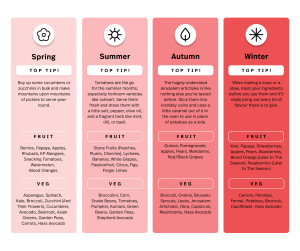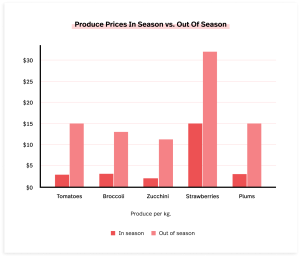
Depending on where you live, there are four seasons in a year (shoutout Arctic Circle for bucking that trend). These seasons can be either starkly different, with the weather changing seemingly overnight, or they can be more gentle, easing in over a couple of weeks until the memory of the previous season’s weather seems like a distant dream.
One thing that these seasons produce (other than distant dreams of clear skies, or sweltering humidity), is an ever-changing landscape of seasonal ingredients.
For the average citizen, this is a minor issue only becoming noticeable when avocados go from 2 for $3 and ripe, to $6 each and rock-hard forever within the space of a week. But for others, namely the people buying in bulk for use in a restaurant, these differences shape their entire menus, and any ignorance of a fluctuating market price could be disastrous for their bottom line.
In this piece, I’ll be highlighting these stark differences, and offer some advice on what to buy, when to buy it, and the suitable substitutes you need to know to keep your menu appealing to the public, and your balance sheet.
- What is seasonal produce?
- Which ingredients should I use for which season?
- How should I use seasonal ingredients?
- How to substitute ingredients throughout the year
- Why are seasonal ingredients so important to a successful menu?
Would you like your menu to be as profitable as possible?
Lightspeed has teamed up with the folks over at FoodByUs to produce an eGuide on how you can turn your menu into a well-oiled, COGS-lowering, profit-boosting machine.
What is seasonal produce?
Seasonal produce is, simply put, anything that thrives at a certain point of the year due to the climate around where it’s produced.
Most of the time this refers to fresh produce such as fruit and vegetables, but it can also extend to livestock, nuts and seeds.
And because the climate plays such a crucial role in producing these ingredients, their availability fluctuates throughout the year, peaking at a time referred to as ‘in season’.
For example, an ingredient like tomatoes needs warm temperatures, plenty of sun, and absolutely no frost. This means that they thrive in spring & summer and will produce the most fruit during those months, making them ‘in season’ between October-February, depending (as always) on the weather.
The very best part about seasonal produce is that when it’s in season, it’s usually at its best (quality-wise) and because it’s producing more, it’s also usually at its cheapest.
Which ingredients should I use for which season?
A challenge for a lot of businesses is trying to figure out which ingredients are at their peak and when, so I’ve put together a little cheat sheet for the seasons to make things a little easier for you.
How should I use seasonal ingredients?
I’ve always been a fan of seasonal ingredients because of their cheap prices and high quality, and it’s because of this quality that I tend to do the bare minimum when I’m preparing them so as to let the ingredient itself really shine through.
This usually means they are dressed with only some good olive oil, salt, and pepper before being cooked (if they even need cooking at all), and letting their natural flavours become dominant.
Another good way to ensure you’re getting the best out of your seasonal ingredients is to create a strong relationship with your supplier. Chat to them before you put your order in, or even if they’ve got time when they’re delivering, and pick their brains about what’s coming into season, what’s headed out, and how best to prepare any ingredients you’re unfamiliar with. Some of my best dishes have started out as a conversation with my fruit & veg guy, and a good supplier is like a database for every type of recipe you can imagine.
And there will come a time where a certain dish is doing so well that to take it off your menu would be tantamount to sabotage, and it’s at these times that a good relationship with your fruit & veg supplier pays dividends. A good supplier will know more than a few substitutions for you to try and keep things as consistent as possible, whilst also considering the quality and cost of your ingredients.
How to substitute ingredients throughout the year
Avocado & garden peas
Even the most staunch avo fan can admit that the hass avocado is the only true way to go, and that shepherds are their rubbery, rock-hard cousins that barely deserve a place on the shelf. So, once the summer months kick in, and the hass exits it’s season for a well-earned rest, don’t substitute it with a shepherd. Instead, consider making a garden pea pureé. It’s green, fresh-tasting, and it captures the mouth feel of a good smashed avo better than a shepherd could ever dream of.
Carrots & beetroot
A good substitution for carrots are beetroots. When in season, both carrots and beetroots come in a variety of colours and when roasted have a sweet, earthy flavour with similar textures.
Brussels sprouts & cabbage
This one’s not as out there as the rest of the substitutions because brussels sprouts are essentially tiny cabbages, but whilst the brussels sprout’s costs will sky-rocket when they’re out of season, the humble cabbage remains quite consistent throughout the year and, cut up small enough, can mimic a brussels sprout quite well, especially roasted or grilled.
Basil, mint, & dill
These three fragrant herbs couldn’t taste more different, but used in place of each other in a recipe, they can soon become interchangeable. If your basil goes brown & slimy before you can make your passata, chop a little mint and chuck that in instead. Likewise, if you’re after something green and flavourful to go atop some fresh strawberries, basil, mint, or dill will make for a pleasant eye-opener and could soon become a go-to favourite.
Why are seasonal ingredients so important to a successful menu?
Apart from the dramatic difference in quality when an ingredient is in season versus when it’s out, the cost of those out-of-season ingredients is a far more important factor to the success of your menu.
You see, when something is out of season, the relative scarcity alone would be enough to drive up costs, but there’s a reason you can get most fresh produce in the supermarket year-round, and that drives up the cost too.
Many supermarkets will buy up produce when it’s in season, and then keep it in cold storage until the fresh supply runs out. They’ll also import a lot of produce from regions where that ingredient’s season differs from ours, and it’s these storage and transportation costs that contribute to the higher price.
To illustrate this, I’ve put together this handy chart which highlights just how drastic these differences in costs can be. As you can see, sticking to an ingredient despite it being out of season could see your COGS rise by almost 600% which, I hopefully don’t have to tell you, is a terrible thing for any menu. Paired with the satisfaction of developing new dishes every few weeks, keeping your menu inline with the seasons is a no-brainer and it’s something every chef should prioritise every time they begin planning their menu.
As you can see, sticking to an ingredient despite it being out of season could see your COGS rise by almost 600% which, I hopefully don’t have to tell you, is a terrible thing for any menu. Paired with the satisfaction of developing new dishes every few weeks, keeping your menu inline with the seasons is a no-brainer and it’s something every chef should prioritise every time they begin planning their menu.

News you care about. Tips you can use.
Everything your business needs to grow, delivered straight to your inbox.


